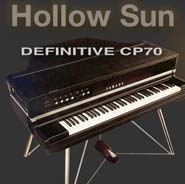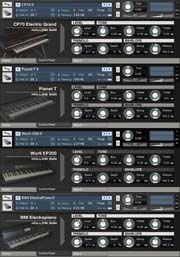 |

|
FEATURES
* Extensive multi-sampling
* Also includes Wurlitzer, Pianet and RMI Electrapiano
* Stereo phaser and chorus effects
* 3-band EQ allows a wide range of sounds
* Tremolo effect
* Control of decay and release times
|
|
|
PRICE - £25 + VAT |
|
|
The quest for a portable piano has been around since the invention of the Fender Rhodes and the Wurlitzer.
Of course, neither of these actually sound like pianos... they have a pleasant sound that is 'piano-like' but in no way are they a substitute for the real thing.
Several companies tried all sorts of things (including some fairly horrible electronic things) but it wasn't until Yamaha released their CP70 'Electric Grand Piano' in the mid-'70s that we had something approaching a 'real' piano that could be toured around and amplified easily without any difficult mic techniques.
There were three models in the product's lifetime... the original CP70 (73-note keyboard) which was superceded by the CP70B (with balanced outputs) and the CP80 (a full 88-note keyboard version). There was also a MIDI version allowing the thing to be used as a monster master controller. These were comparatively rare however. All of them featured true grand piano action keyboards which, if you were a real piano player, were a delight to play.
In their brochures, Yamaha claimed their electric grand pianos were "compact" and "portable". I am not convinced! They measured at least 57 inches wide by 45 inches deep (front to back) and weighed as much as 313lbs! I guess that at a time when bands were going out with Hammond organs, Leslies, CS80s, multiple MiniMoogs, Mellotrons and so on, the CP piano was comparatively 'portable'. |
 The CP70 must be an elusive sound to capture; the sampled renditions of this instrument that I've encountered so far seem to lack a certain 'je ne sais quoi', somehow failing to convey its unique character convincingly. It's notable then that Hollow Sun have rendered this amazingly accurate and instantly recognisable representation, which is a real pleasure to play. The CP70 must be an elusive sound to capture; the sampled renditions of this instrument that I've encountered so far seem to lack a certain 'je ne sais quoi', somehow failing to convey its unique character convincingly. It's notable then that Hollow Sun have rendered this amazingly accurate and instantly recognisable representation, which is a real pleasure to play.
The dynamic response is surprisingly wide, smooth and realistic.
I just wanted to thank you for your truly inspiring CP 70 sample library.
I've been searching for one for a long time and can't tell you how much joy your works brings me!
Much appreciated, and thank you so very very much for making it so affordable for us independent musicians
Robert Strauss - WAX studios
Just bought your CP70 sample - it is absolutely awesome!!!!!
I own a CP70 and wanted an easy way to take it on the road, also to record it without audio blips so looked into a sample. I will be closely looking at your future products! I think your sample is so realistic!
Well done steve man, its ACE. Hitch Thompson - email
The new version with the panel is great. i am able to re-create so many of my favourite CP70 sounds especially with the EQ. 10/10
Jon - via email
I bought this for the CP70 because I always loved that sound but I used to have a Wurlitzer and a Pianet before that and I find myself playing these more than the CP70. LOL!
Very good collection of electric pianos. You should do a Rhodes to complete the collection.
Tony - via email
These are fantastic electric pianos. Thank you.
Sky - via email

We just bought it and put it in a song and it sounds ridiculously amazing!
Thanks man.
Ed Cash - Producer (Amy Grant and others), song writer, multi-instrumentalist, BMI and GMA award winner |
|
|
To make it easier to transport, the CP piano dismantled into separate units with the strings and frame in one case and the keyboard, legs and sustain pedal in another (left) which made it slightly more managable. It was re-assembled with some clever lock catches. Even so, it was a two man job to cart it around.
On a long tour, however, it wasn't just roadies you needed to employ to look after the thing.
Because it was a 'real' piano, it had 'real' srings and so needed regular tuning by a qualified piano tuner especially when the instrument was being thrown in and out of trucks! Because this was a luxury that not every one could stretch to, the CP70 gained a reputation for being a bit of a 'honky tonk' piano because many were heard slightly the worse for wear and out of tune. |
This reputation was not helped by the fact that one of the CP piano's more famous users, Peter Gabriel, always ran his CP through a vintage Roland Chorus pedal! It's a shame really because the CP is actually a nice sounding piano when looked after.
|

|
The CP piano's sound was achieved using a traditional grand piano hammer action hitting real strings. However, Yamaha developed special strings that could be made shorter and require less of them but still be able to retain an authentic acoustic piano sound. So, unlike ordinary acoustic pianos that typically have three strings for each of the middle and upper register's notes and two strings for each of the bass notes, the CP piano used two specially designed strings for each of the mid and upper notes and just one string for each of the bass notes.
Of course, this also greatly reduced the internal stress and tension on the string frame which did not have to be as big or as strong (or as heavy) as an acoustic grand's. And because the sound was amplified electronically, the casework did not have to be designed for acoustic projection as is the case with acoustic pianos.
In all, the CP electric grand was a triumph of mechanical engineering. |
It was a triumph of electrical engineering too.
Under each string was an independent piezo-electric pickup that was used to amplify the sound. This custom design eliminated any possibility of 'howl around' even at high volume and for most, this was more than adequate.
However, one 'golden ear' user preferred to have a set of pickups made by Charles Helpinstill fitted instead. Helpinstall had been designing and manufacturing high quality and specialised pickups for acoustic pianos for many years and his designs were used by nearly all the leading piano players of the '70s and '80s in their live acts. Charles says of this CP70 conversion "I only remember doing this once in the late '70s, and with no real improvement to the piano. The fact that the CP-70 has no soundboard pretty much confines it to a unique sound (for better or worse)". |
|
Both models had a 3-band equaliser for LF/MF/HF tonal modification. They also had a TREMOLO effect built in. The CP80 also had a 3-way BRIGHTNESS switch. There was also a master volume control and to the left of this were insert points where you could patch in your own effects. |
In its heyday, the Electric Grand was regarded as an instrument in its own right and not just a portable alternative to a real piano for live use and many artists used them in the studio in place of (or as well as) acoustic pianos. Often this was for convenience (plugging in a cable is a lot easier than mic'ing up an acoustic piano) but often, it was used for its unique sound.
Of course, with the advent of high quality digital pianos (many from Yamaha themselves!), the CP series became increasingly redundant both live and in the studio and it was eventually discontinued in the mid-'80s. However, the Yamaha Electric Grands remain today as classic and innovative instruments with a classic 'sound'.
It has been used in the past by the aforementioned Peter Gabriel and also Abba, U2, Simple Minds, George Duke, Bruce Hornsby, Genesis/Tony Banks and countless others. More recently, the UK band Keane have adopted the Yamaha CP as their primary piano sound and it is a trademark component in their music!
The Hollow Sun Definitive CP70B features a re-conditioned CP70B from which every note has been recorded, full length (over a minute at lower registers!) which, with a piano action master keyboard reproduces as closely as possible the feeling of playing 'the real thing'. Even with a synth action keyboard, the sound is fabulously authentic!
Several other landmark electric pianos such as Wurli EP200, Pianet and the RMI ElectraPiano are also included in the package. |
| THE KONTAKT CONTROL PANEL |
Each instrument now features a complete control panel so that you can create your own unique sounds pretty much like using 'the real thing'.
There are three panels - MASTER, CONTROL PANEL and EFFECTS.
In MASTER, you can set 'global' functions such as velocity sensitivity and curve, note range, pitch bend range and master tuning and transpose.
In CONTROL PANEL, you can modify the tone of the instrument using the 3-band EQ as found on the original CP70. You can also add tremolo (again, like the original) with variable speed and depth.
In EFFECTS, you can add a phase shifter effect with variable amount and speed and you can add (or remove) chorus and reverb.
Any settings you make can, of course, be saved for future recall and it is also possible for a knobby hardware controller to 'learn' these controls for an even more hands-on experience.
You can download the CP70 II User Guide HERE
And as an added bonus, also included are several other classic electric pianos, namely the Wurlitzer EP200, Hohner Pianet T and RMI ElectraPiano.
All of them have been similarly scripted making them extremely flexible |

Click to see full panel |
 |
|
| NOTE : It will work with the Kontakt Player but only in 'demo' mode and the session will be time limited. |
|
|
|
All company/trade/brand names shown or implied are the property of their owners. |
HOLLOW SUN © |
|
|
|
|